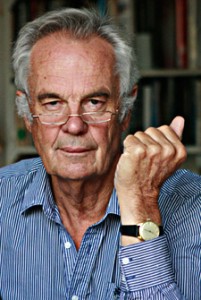If it bleeds it leads!
By Jonathan Power
If it bleeds it leads! The mantra of many a newsroom. In their new book, “Pax Ethnica” two great journalists, Karl Meyer and Shareen Brysac, argue that day in and day out ethnic conflict and tension along religious and cultural lines makes for reliable, if dispiriting, headlines.
Journalists regularly play plenty of attention to failed states, sectarian violence and societies at the breaking point. But what about those unsung exceptions, the communities of the world where diverse groups live together in harmony?
There are many myths that pervade both newsrooms and popular consciousness around this subject. In the last three weeks I have been reporting from Nigeria where one third of all the black people in the world live. For many it is still considered a failed state mired in corruption and violence in the oil producing Niger delta region and now with Boko Haram in the north. In fact it is a fast emerging economic success with the last election accepted as very fair. The delta is almost quiet. But find that in your newspaper or on TV you will be lucky.
Similarly, there is almost nothing on the fact that the number of civil wars in Africa has fallen dramatically and that all over the world conflict has sharply diminished in the last decade. Battle deaths have fallen sharply and those dying as a result of war have also steadily decreased.
Meyer and Brysac concentrate their fire on five areas of the world where disparate peoples who could well have cause to hate and fight each other get along.
For over a century Germany and Denmark were at loggerheads over a piece of territory called Schleswig-Holstein. It was one of the big divisive issues of the day. Amusingly, during one of its periodic crises, Prime Minister Lord Palmerston explained to Queen Victoria, “Only three people have ever understood the Schleswig-Holstein business – the Prince Consort, who is dead – a German professor who has gone mad- and I, who have forgotten all about it”.
The pot continually was stirred by unscrupulous nationalists. In Cologne, Karl Marx ran a newspaper, the Neue Rheinische. It derided the Danes as oafs and peasants who ungratefully relied on Germans for what passed as their culture.
Although it was predominantly German speaking, Denmark had long ruled the province until Bismarck snatched it away by war and suppressed the Danish part of the population. At the end of the Second World War Britain offered Denmark the return of the land. In a magnanimous gesture Denmark said “no” on condition that the language and cultural rights of Danish speakers be respected. A running sore was healed.
In the autumn of 2005 there were race riots in many parts of France but the southern port of Marseilles, which has more than its fair share of immigrants, mainly north African Muslims, remained quiet. The critical catalyst was the role of three consecutive mayors and the leaders of the Islamic, Orthodox, Christian and Jewish communities. Although there is a broad north/south divide in the city immigrant communities are not bunched into ghettoes as in the suburbs of Paris. As important, the city’s diverse inhabitants identify themselves proudly as Marseillais – a civic pride fortified by a good soccer team and by concerts of local rap stars and the cohesive work of schools and civic action groups.
There is a similar story in Russia where in Tatarstan the majority Muslim population and minority Orthodox population live together harmoniously. The Orthodox cathedral adjoins one of Europe’s biggest mosques – the very emblem of centuries of proud tolerance reinforced by its long-time former president, Mikhail Shaimiev, who wrested from Moscow a form of “sovereignty” that gives the republic an unusual measure of autonomy while respecting the cultural rights of all its citizens both Tartars and Russians.
In Kerala, the Christian, least corrupt, healthiest and best educated state in India, the state has been riot proof and values its highly diverse population. At one time, but no longer, it had the most severe and oppressive caste system in India. A key factor in producing harmony has been the long-ruling communist party which has out-democratised most other parts of India. Elections regularly involve a peaceful rotation of power- with the empowerment of women an added essential catalyst.
Finally, the authors look at the borough of Queens in New York, arguably the most diverse place in the world, with its 2.3 million residents speaking 138 languages. There are many elements in its success – the way its schools and hospitals are run but, perhaps most of all, its ubiquitous libraries with DVDs in several Indian languages, Nollywood films from Nigeria, homework help in Hindi and computer classes in Spanish,
One can’t be quite so pessimistic about the world’s divisions if one studies these five examples. Why don’t the media focus more on what works?
Copyright: Jonathan Power
